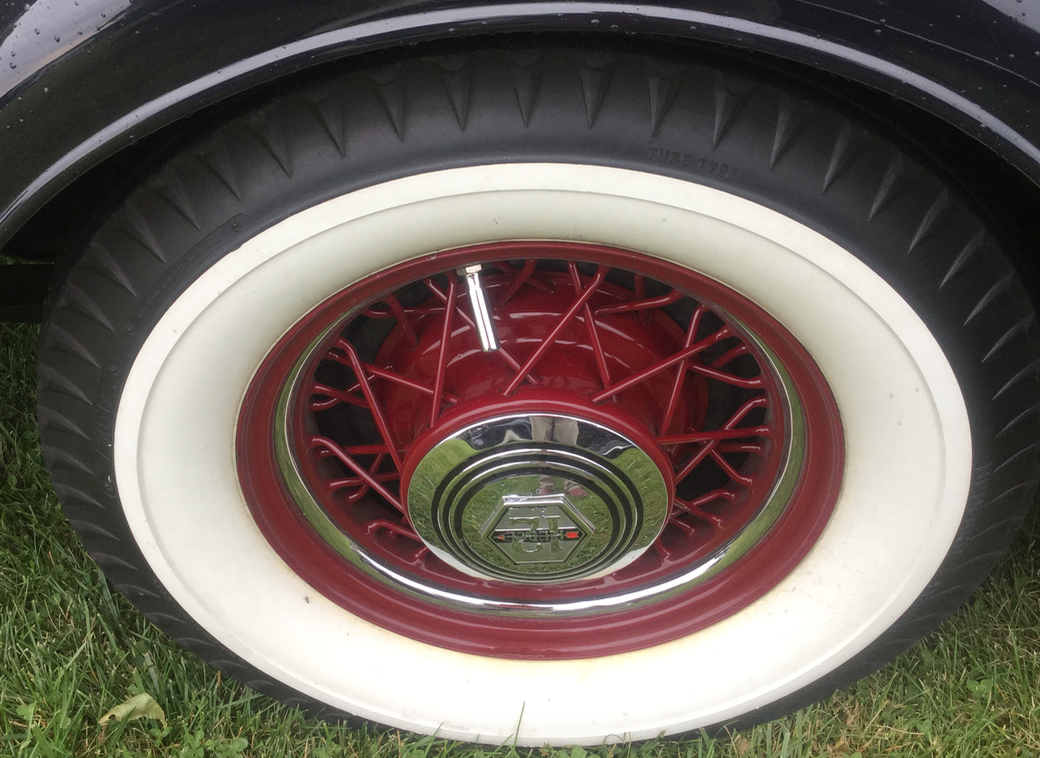- Home
- About Us
- Join/Renew
- Member Benefits
- Member Pages
- Log In
- Help
- Museum Store
I would like to purchase 2 more Optima batteries.
Pictures indicate a 1935 hood side and instrument group.
On the back side of the dash is a washer and nut on a threaded shaft that compresses and holds the switch. The knob can be removed by unscrewing a set screw.
Bill,
1933 17″ wire wheels were either painted following the company’s color schemes or if the vehicle was a salon model (chrome outside horns, chrome radiator shell and shutters, right rear tail light, additional paint colors available etc,) a 3/4″ appearance ring (named in parts catalog) or trim ring was applied where the striping on your wheel is located. Both wood wheel(natural or painted) and steel wheels (painted or chrome plated) were available and could have had striping applied. Also Budd stainless steel wheels were available as an accessary wheel, but are not listed in the parts book. I do not remember observing striping on welded wire wheels but obviously a former owner wanted that special effect…
You failed to provide a dimension of the emblem, but if it is the horn button it was used on 1933 1242 and 1247 wheel assemblies and the light and throttle arms were made of pot metal and were all chrome plated. Many were broken when the driver’s sleeve caught the light arm, which is left of center.
originally the passenger front door had the lock, but today maybe the lock should be assembled on the drivers side front door if you have both available
service bulletin 1974 #3 has dictator,commander and president transmission, tree wheeling and overdrive information on disassembly, operation and rebuilding. Based on 1935 models with the information applicable to PA transmissions 1932-38.
#6 the rod attaches to the arm of the clutch pedal.
the Brillman Co. makes delco remy tags for 6V electrical applications
The one on the left is used on the 1933 cars but the one that holds the hood hinge is longer than what appears in the picture.
Is there any evidence of what Lloyd used taking car of the car for so many years in the garage?
A long stud with decorative acorn nut was used to help seal the covers over a cork gasket around the perimator.
Is not. The outlet exits perpendicular to the two securing holes
The red reproduction button came in the meet packet for the 100th anniversary meet held in Buffalo in 1978. It was “picnic event”” for the founding of the company.”
PAS provided the buttons for one of the past annual meets.
The center temperature gauge face and the right fuel gauge match for a 1933 836 or 1236. The background is black with white letters that identify FUEL. On the opposite side of the opening for the glass tube is a vertical “capsule shaped” white patch that has black numbers that identify the quantity 0,5,10,15,20,25 gallons. Heavier black lines extend to the opening @ 5 (gal) intervals and on some gauges there are 4 thinner lines between the major lines. The 1934 fuel gauge has a black background with white letters to identify FUEL on the right of the opening and on the left white numbers with tick marks to the right of the numbers 0,5,10,15,20,25. Within the instrument panel the FUEL gauge was on the left side. Lange’s gauge is from a 1934 but have not deducted from a judged event.
the switch turns on the instrument lights. I turned off John C. instrument lights @ St. Louis meet.
I looked at a 33′ 1236 radiator assembly and the radiator shell is attached to a bracket that extends out from the radiator core on both sides, has the emblem at the bottom and has [2] domed slotted head screws the hold and allow the lower apron to slide into. The lower apron holds the bottom of the shutter assembly and is attached to another set of brackets that match the width of the radiator core. The outer portion of the apron includes a small fixed shutter. The two screws on the radiator side of the apron hold the center piece of the shutter assembly. Since the apron slides down around the domed screws and the radiator shell rests on or very close to the front fenders, the shell could not be separated unless the screws were removed and the shell was pulled toward the front of the car. I wonder if there is a nut/bolt behind the emblem.
There are two additional tabs under the window channel held in place by 1/2″beveled head wood screws. Probe thru the felt to locate them. There are two tabs secured with screws on each side.”
the cover is a circle that covers the shiny portion in the picture with elongated tabs made of flat stock. Within the tab is a hole for a bolt on one side and a slot in the other tab. To check the marks the two bolts were loosened and the cover was rotated in the slot to view through the hole. With your talents easy to make. I can follow up when I return from Hershey.
